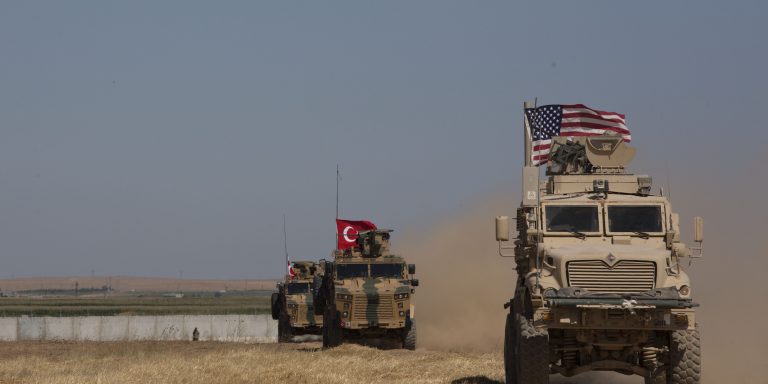INTELBRIEF
October 3, 2019
IntelBrief: The U.S. Struggles to Gain Leverage in Syria

- The Assad regime again demanded the immediate withdrawal of U.S. and Turkish troops from Syria, labeling them ‘occupying forces.’
- Meanwhile, the United States and Turkey are finalizing a so-called safe zone along Turkey’s eastern border with Syria, which will introduce ancillary issues.
- The U.S. continues its primary mission of counterterrorism and is increasingly concerned about Hurras al-Din, al-Qaeda’s affiliate in Idlib province, Syria.
- There are approximately 1,000 U.S. troops still in Syria and it is likely the United States will remain in the country for the foreseeable future.
.
U.S. military personnel in Syria number approximately 1,000 and their tasks remain exceedingly complex in one of the world’s most complicated military and geopolitical environments. While President Trump had stated that U.S. troops had ‘defeated’ the so-called Islamic State and would be leaving that country quickly, this has not happened, although the troop numbers were reduced by half. The United States now seems stuck in Syria’s quagmire, fearing that outright withdrawal could endanger tangible but tenuous gains made by the U.S.-backed Syrian Democratic Forces (SDF). The Assad regime once again denounced the U.S. presence in Syria, along with the presence of Turkish troops in northern Syria. While Russia, Iran, and their respective proxies operate in Syria to bolster Assad, the United States and Turkey have established long-standing positions in northeastern Syria for their own respective national security interests over the objection of the Assad regime. During a September 28 speech at the United Nations General Assembly meetings, Syria’s Foreign Minister Walid al-Moallem said his government viewed the U.S. and Turkish troops as ‘occupying forces.’ He went on to deride the ongoing talks between the United States and Turkey about a safe zone along the Turkish-Syrian border as ‘arrogant,’ saying the Syrian government rejected any agreement about its territorial integrity made by unwelcome outside parties.
The talks between Ankara and Washington over the safe zone have been cumbersome and plagued by frequent setbacks. Unsurprisingly, Turkey remains anxious over the presence of Kurdish militias along its border. Progress over the safe zone has ebbed and flowed, as each side attempts to negotiate a proposal calling for a jointly-patrolled zone between three and eight miles deep into Syria from the Turkish border. As much as the United States tried to avoid becoming enmeshed in the Turkish-Kurdish dispute, the military success of the SDF ensured that Washington would need a partner on the ground. The presence of U.S. troops is intended to be a bulwark against Turkish aggression against the Kurds, Washington’s most capable ally on the battlefield in the fight against the Islamic State, while Turkey labels the Syrian Kurds as terrorists themselves.
It is important to note that the legal justification for the U.S. military to operate in Syria continues to be based on the 2001 Authorization for the Use of Military Force (AUMF). This authority delegated broad powers to the President to fight al-Qaeda in the immediate aftermath of September 11, 2001 attacks. Nearly two decades later, al-Qaeda has continued to morph, and the United States is now increasingly concerned that al-Qaeda’s affiliate in Syria, Hurras al-Din, is growing strong enough to pose a significant threat to the United States and its allies in Europe from the group’s base in Idlib province and areas to its north. In Idlib, the last anti-regime stronghold in Syria, rebels have been cornered by Syrian forces backed by Russian airpower. Hurras al-Din has largely been contained in Idlib but the presence of Russia makes it difficult for the United States to fully surveil potential targets and any U.S. strikes need to be deconflicted with Moscow.
Meanwhile, the Islamic State is rebuilding in parts of Syria’s rural Sunni heartland in the east of the country. The very conditions that fueled its rise still exist—abysmal governance, the spread of violent ideology, a country awash in weapons and conflict, economic devastation, and virulent sectarianism. The Islamic State can still conduct infrequent large-scale attacks while engaging in a persistent low-level campaign of targeted killings, political assassination, and ambushes. The United States remains concerned that the military gains made by the Global Coalition to Defeat ISIS will be nullified if security and political conditions of the ground fail to improve. For these reasons, as well as a stated goal of countering Iran’s influence in that region, the U.S. military is likely to stay in Syria for the foreseeable future, acting as both a counterterrorism strike force but also as a deterrent to keep tensions from escalating between Turkey and the Kurds as a potential safe zone is created.
.
For tailored research and analysis, please contact: info@thesoufancenter.org